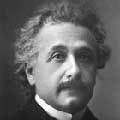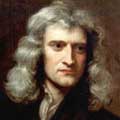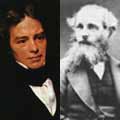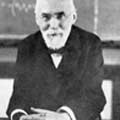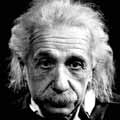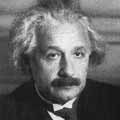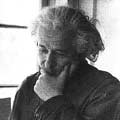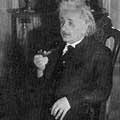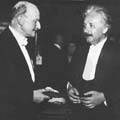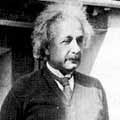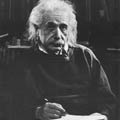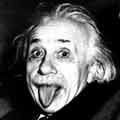Albert Einstein's Theory of General Relativity
When forced to summarize the general theory of
relativity in one sentence:
Time and space and gravitation have no separate existence from matter. (Albert Einstein)
Introduction to Albert Einstein's General Relativity
On Accelerated Motion and Gravitation, 1915
General Relativity extends special Relativity to include accelerated Motion,
and the relationship between Force, Mass and Acceleration (and Time and
Dimension), thus it is important to first ask 'Why does Acceleration of
Matter in Space Exist in our Universe?'
Only once we understand this can we possibly understand Albert Einstein's General Relativity.
The solution
is quite simple. By understanding the Spherical In and Out Wave structure
of Matter (SSWs) we deduce that any change in velocity of the In-Waves (Principle
Two) causes a change in where the In-Waves meet at their Wave-Centers which
we observe as the accelerated Motion of the particle. This is why acceleration
exists and is defined as a change in velocity - because it is caused by
a change in velocity of the In-Waves!
This change in the velocity of waves in Space is dependent upon the mass-energy density of space (for Gravitational Mass), and is the true physical cause of General Relativity and Albert Einstein's gravitational fields, thus explaining Albert Einstein's comment that;
(Special relativity is founded) on the basis of the law of the constancy of the velocity of light. But the general theory of relativity cannot retain this law. On the contrary, we arrived at the result that according to this latter theory the velocity of light must always depend on the co-ordinates when a gravitational field is present. (Albert Einstein)
Let us now consider the concept of Mass more closely.
On Inertial Mass and Gravitational Mass
Now for the principle of the conservation of mass. Mass is defined by the resistance that a body opposes to its acceleration (inert mass). It is also measured by the weight of the body (gravity mass). That these two radically different definitions lead to the same value for the mass of a body is in itself an astonishing fact. ... According to the principle - namely, that masses remain unchanged under any physical or chemical changes - the mass appeared to be the essential (because unvarying) quality of matter.
Physicists accepted this principle up to a few decades ago. But it proved inadequate in the face of the special theory of relativity. It was therefore merged with the energy principle. ... We might say that the principle of the conservation of energy, having preciously swallowed up that of the conservation of heat, now proceeded to swallow that of the conservation of mass - and holds the field alone. (Albert Einstein, 1946)
It is an unsatisfactory feature of classical mechanics that in its fundamental laws the same mass constant appears in two different roles, namely as 'inertial mass' in the law of motion, and as 'gravitational mass' in the law of gravitation. (Albert Einstein, 1936)
Let us then explain these two related forms of Mass, Inertial and Gravitational, as then we can clearly understand why they are equivalent
a) Inertial Mass
Imagine the Wave-Center (electron) of a Spherical Standing Wave (SSW) in free Space away from massive bodies. As the mass-energy density of space is the same in all directions, therefore the velocity of the In-Waves is the same from all directions and does not change, thus the In-Waves will always meet at the same point in Space (the Wave-Center). This is the physical foundation of inertial mass - a body remains stationary (it does not accelerate) if there is no change in the velocity of the In-Wave. (No forces act upon it.)
b) Gravitational Mass
Consider the same stationary Wave-Center (electron) of a SSW but now imagine
a massive body, such as the Earth, placed to one side of the electron. What
effect will this have?
We can consider this massive body, the earth, as a place of Space of very high mass-energy density of space. Therefore the velocity of In-Waves and Out-Waves (velocity of light) will be slower in this Space as Principle II states. This therefore causes a change in shape of the In-Waves (and Out-Waves) due to a slowing of their velocity in this high mass-energy density of Space resulting in a change in ellipsoidal shape or the SSW and results in the Wave-Center (electron) moving towards the Space of higher mass-energy density of space (the earth).
On the Equivalence of Inertial Mass and Gravitational Mass
And so we see that it is Principle Two which causes both gravitational mass
and inertial mass. As it is the same principle that causes both, this explains
their equivalence.
Let us now consider a simple example of this equivalence that will make it easier to understand.
Imagine standing in a room, the room existing in Space away from any stars or other massive bodies. We would be weightless in the Space as there would be no gravitational effect.
Now if we imagine the room being accelerated upwards, (relative to the floor), at 9.8m/s, as the occupant of the room, we would not be able to tell if we are being accelerated or if we are in the Earth's gravitational field.
Further, if there is a rope attached to an object hanging from the ceiling of the room, the tension in the rope could be due either to the inertia caused by accelerating the room, or to the object's weight due to its mass in a gravitational field. This is the empirical equivalence of gravitational and inertial mass.
The establishment of this general principle of relativity is made easier by a fact of experience that has long been known, namely, that the weight and the inertia of a body are controlled by the same constant (equality of inertial and gravitational mass). This hasty consideration suggests that a general theory of relativity must supply the laws of gravitation, and the consistent following up of the idea has justified our hopes. But the path was thornier than one might suppose, because it demanded the abandonment of Euclidean geometry. This is what we mean when we talk of the 'curvature of space'. The fundamental concepts of the 'straight line', the 'plane', etc., thereby lose their precise significance in physics.
In the general theory of relativity the doctrine of space and time, or kinematics, no longer figures as a fundamental independent of the rest of physics. The geometrical behaviour of bodies and the motion of clocks rather depend on gravitational fields which in their turn are produced by matter. (Albert Einstein, 1919)
The principle of the equivalence of inertial and gravitational mass could now be formulated quite clearly as follows: in a homogenous gravitation field all motions take place in the same way as in the absence of a gravitational field in relation to uniformly accelerated co-ordinate system. (Albert Einstein, 1934)
There is no reason to exclude the possibility of interpreting this behaviour as the effect of a 'true' gravitational field (principle of equivalence of inertial/gravitational mass). This interpretation implies that A is an 'inertial system', even though it is accelerated with respect to another inertial system. (Albert Einstein, 1950)
And so we see that Albert Einstein based his mathematics
for gravitation, on the fact that Matter in an accelerated reference frame
(Inertial Mass) behaved the same as Matter in a gravitational field (Gravitational
Mass). (Principle of Equivalence.)
Thus if we know the Lorentz transformation for moving with a constant velocity, (which require linear transformations of the co-ordinate system) then we can calculate how the Lorentz transformation would change if the reference frame is now accelerated.
.. the theory of gravitation is based on the principle of equivalence discussed above and rests on the following consideration: according to the theory of special relativity, light has a constant velocity of propagation. If a light ray in a vacuum starts from a point, designated by the co-ordinates X1, X2, and X3 in a three dimensional co-ordinate system, at the time X4; it spreads as a spherical wave and reaches a neighbouring point (X1+dX1, X2+dX2, X3+dX3) at the time X4+dX4. Introducing the velocity of light, c, we write the expression:
dX12 + dX22 + dX32 = (c.dX4)2
This expression represents an objective relation between neighbouring space time points in four dimensions, and it holds for all inertial systems, provided the co-ordinate transformations are restricted to those of special relativity. The relation loses this form, however, if arbitrary continuous transformations of the co-ordinates are admitted in accordance with the principle of general relativity. (The equations expressing the laws of Nature must be covariant with respect to all continuous transformations of the co-ordinates. This is the principle of general relativity.) (Albert Einstein, 1954)
Albert Einstein is thus forced to use a curved (non-linear) co-ordinate system (rather than linear as per Special Relativity and the Lorentz Transformations), which he found from the work of Gauss and Riemann (called symmetrical tensors).
In order to account for the equality of inert and gravitational mass within the theory it necessary to admit non-linear transformations of the four co-ordinates. Mathematics suggests an answer which is based of the fundamental investigations of Gauss and Riemann. (Albert Einstein, 1954)
To introduce this non-linear transformation, it was necessary for Albert Einstein
to adjust the velocity of light dependent upon the energy density (gravitational
field) of Space. This is true, because it is this change in velocity of
Wave Motion that is the cause of Gravity.
As Albert Einstein says; (and we know that we have repeated this quote - but it is important and misunderstood!)
(Special relativity is founded) on the basis of the law of the constancy of the velocity of light. But the general theory of relativity cannot retain this law. On the contrary, we arrived at the result that according to this latter theory the velocity of light must always depend on the co-ordinates when a gravitational field is present. (Albert Einstein, 1954)
Albert Einstein's Theory of General Relativity
Help Humanity
"You must be the change you wish to see in the world."
(Mohandas Gandhi)
 "When forced to summarize the general theory of relativity in one sentence:
Time and space and gravitation have no separate existence from matter. ... Physical objects are not in space, but these objects are spatially extended. In this way the concept 'empty space' loses its meaning. ... The particle can only appear as a limited region in space in which
the field strength or the energy density are particularly high. ...
"When forced to summarize the general theory of relativity in one sentence:
Time and space and gravitation have no separate existence from matter. ... Physical objects are not in space, but these objects are spatially extended. In this way the concept 'empty space' loses its meaning. ... The particle can only appear as a limited region in space in which
the field strength or the energy density are particularly high. ...
The free, unhampered exchange of ideas and scientific conclusions is necessary for the sound development of science, as it is in all spheres
of cultural life. ... We must not conceal from ourselves that no improvement in the present depressing situation is possible without
a severe struggle; for the handful of those who are really determined to do something is minute in comparison with the mass of the lukewarm
and the misguided. ...
Humanity is going to need a substantially new way of thinking if it is to survive!" (Albert Einstein)
 Our world is in great trouble due to human behaviour founded on myths and customs that are causing the destruction of Nature and climate change. We can now deduce the most simple science theory of reality - the wave structure of matter in space. By understanding how we and everything around us are interconnected
in Space we can then deduce solutions to the fundamental problems of human knowledge in physics, philosophy, metaphysics, theology, education, health, evolution and ecology, politics and society.
Our world is in great trouble due to human behaviour founded on myths and customs that are causing the destruction of Nature and climate change. We can now deduce the most simple science theory of reality - the wave structure of matter in space. By understanding how we and everything around us are interconnected
in Space we can then deduce solutions to the fundamental problems of human knowledge in physics, philosophy, metaphysics, theology, education, health, evolution and ecology, politics and society.
This is the profound new way of thinking that Einstein
realised, that we exist as spatially extended structures of the universe - the discrete and separate body an illusion. This simply confirms the
intuitions of the ancient philosophers and mystics.
Given the current censorship in physics / philosophy of science journals (based on the standard model of particle physics / big bang cosmology) the internet is the best hope for getting new knowledge
known to the world. But that depends on you, the people who care about science and society, realise the importance of truth and reality.
It is Easy to Help!
Just click on the Social Network links below, or copy a nice image or quote you like and share it. We have a wonderful collection of knowledge from the greatest minds in human history, so people will appreciate your contributions. In doing this you will help a new generation of scientists see that there is a simple sensible explanation of physical reality - the source of truth and wisdom, the only cure for the madness of man! Thanks! Geoff Haselhurst (Updated September, 2018)
A new scientific truth does not triumph by convincing its opponents and making them see the light, but rather because its opponents eventually die, and a new generation grows up that is familiar with it. (Max Planck, 1920)
| Tweet Follow @philosophytruth | |
| Geoff | |
Connect with Geoff Haselhurst at Facebook
"All that is necessary for evil to succeed is for good people to do nothing."
(Edmund Burke)
"In a time of universal deceit - telling the truth is a revolutionary act."
(George Orwell)
"Hell is Truth Seen Too Late."
(Thomas Hobbes)
Legal Disclaimer and Privacy Policy
